| Patches & Memorbilia |
LODGE FLAPS
The lodge gratefully acknowledges the contributions of the following individuals in the preparation of this book. Dr. Bryce Fairbanks, David E Halliday, Rod Mosbacker, Wayne Moyle, Geraldine Munford, Carey Beckstead, and others.
We are especially grateful to David L. Munford the designer of many of our lodge flaps and incidental patches. Dave compiled the basic photos in this archive and produced the text from his research. It is, in many of the patches, his artistic ability and support that is on display. We also express our thanks to Celestial Creations who have been the representative to see that our patches are manufactured to the artist's specifications.
If you want to start a collection, you can download a check list here.
INTRODUCTION
From the commencement of the Lodge in 1956 the membership has been identified by a distinctive pocket flap. Being irregular in design, it has attracted national attention. In recent years improvements in the design and variety of colors (currently 14) have made it popular with arrowmen from across the nation among those who collect and trade flaps.
Beginning in 1981, the 25th Anniversary of the Lodge, the lodge began to produce flaps for special occasions on a limited basis. Usually the purchase of these items has been limited to 1 or 2 per member during the period that the flap has been offered.
With the growth of the lodge in the 1980s, the lodge has offered special pins, slides, and other memorabilia to its members. Fellowship patches and occasional chapter patches have made additional items that have been eagerly sought after to complete collections. Only the Flaps are presented here.
Information concerning some of the items has been lost with the passage of time such as the exact number produced or the names of those who designed a certain item. Any information available, not included in these pages should be sent to the lodge secretary in care of the Great Salt Lake Council, BSA. Every attempt to be accurate has been made, but with the passage of time some errors will have persisted in its pages.
Since some in recent years have attempted to claim authenticity for a particular patch or item that may not be authentic, only those items used by the lodge membership as authentic lodge memorabilia have been included. If the item has not been included, it is not authentic.
During its history, the lodge has produced a variety of tee-shirts, hats, binders, staff jackets for one event or another and many printed items. No attempt has been made to include this material since it is usually not of interest to the collector and has no special historical interest to the lodge.
Patches have been included as a different issue in each case where there is a significant design difference. Often the change of a manufacturer or a different loom run will produce a patch of minor variation. Those minor variations have not been noted as variations. It is up to the collector to decide how many variations he wants to include in his collection. It has been the policy of the lodge to have the patches produced by the lowest cost manufacturer and often manufacturers have changed from one run to the next even though the design has remained the same.
Only patches and other items officially approved by the Lodge Executive Committee are listed. Items that cannot be documented or are of questionable authenticity have not been included.
While every opportunity has been taken to make sure the information contained in this book is correct, we recognize that there are errors and apologize for them. Information on corrections will be gratefully accepted.
Yours in Brotherhood,
The Lodge Officers
HISTORY OF THE LODGE
The EL-KU-TA Lodge was founded in 1956. It was an outgrowth of previous organizations (the Cha-Utes and the Order of the Uinta Moon) formed at Camp Steiner for the purpose of honoring those campers who were outstanding.
The first charter was granted in 1956 (although some members believe a chapter was issued earlier and then allowed to lapse) which marks the formal beginning of the lodge. It has continued since that time. During this time it has provided leadership to many council and section activities. In fact, it is known for the outstanding quality of its youth leaders, having provided the Western Region Chief, Ryan Mecham, in 1990, the National Chief, Ryan Pitts, in 1996 and the Western Region Chief, Brandon Fessler in 1998.
NUMBER SYSTEM
For purposes of this publication only official patches of the lodge are included. Official means that the item has been voted upon and approved by the lodge executive committee and has been available to the general membership of the lodge (or chapter where indicated). There are those who have claimed some degree of authenticity for a certain item from time to time. Those claims have been rejected for items not available to the general membership or not approved by the Lodge Executive Committee and it is assumed that those items are not official memorabilia of the EL- KU- TA Lodge.
For the purpose of the membership of the lodge a numbering system has been adopted for the identification of each item produced by the lodge and covered by this book. This may not be the same as other publications might use.
The system is as follows: Regular Issue Flaps: F series for partial embroidered S series for fully embroidered
REGULAR ISSUE FLAPS
Regular issue flaps are defined as the flaps that the lodge issues for current wear. There is no restriction on the flap with each member being able to buy as many as desired. No sales of flaps are made to members of other lodges. Regular issue flaps are purchased as needed generally in lots of 1000 or more. They are most likely to have minor differences between loom runs etc.
The design for regular issue flaps is proposed to the lodge and voted on by the Lodge Executive Committee prior to being produced.
The first four flaps were made for the fledgling lodge of limited membership and it appears that a small number of flaps lasted the lodge for a period of several years.
After a trip to the National Jamboree in 1964, the lodge had seen a lot of the new style, fully embroidered, from other lodges across the country, and desired a new flap in keeping with additional colors and better artwork. The lodge flaps took on a new look and become more colorful. During the late 60s the membership was increasing dramatically with over 1700 ordeal candidates being inducted in 1969.
Membership soon settled down to about 4-500 for most of the mid and late 70s. In 1981 membership again started to increase and flaps become more and more in demand. It had always been the custom to present a lodge flap to each new ordeal candidate as part of the ordeal.
In 1985 for the preparation of the National Jamboree, the lodge flap went through another major re-design. Its colors increased to 14 with an outstanding professional quality to the workmanship. This period has seen the flap become one of the most sought after in the country by traders and collectors.
Generally designs are initiated by the lodge officers or the chairman of lodge events. Sketches are made and submitted to commercial artists to bring out the best of the design. The designer is credited as being the one who originally developed the sketch or idea. Often the designer is unknown since the lodge has not kept records of who made the design.
F-l 
Date issued: 1956
Issued: 220 est.
DESCRIPTION: The first lodge flap of the new lodge in Salt Lake had two Indian braves facing each other, in a sign of brotherhood for all Arrowmen and a prominent elk in the center to become the totem or symbol of the lodge name - Elk of Utah. The elk has been on every lodge flap since its introduction in 1956, and taken on a variety of looks, sizes and colors. The first elk that appeared was brown with black antlers, five points on the left side and four points on the right. A black arrow appeared behind the elk's head and the words EL-KU-TA were written in red at the top of the flap. The words GREAT SALT LAKE appeared at the bottom of the flap in a medium brown color.
Another interesting feature of the first lodge flaps was that the Indians that are facing each other have a single red feather that hangs off the outer edge of the patch. This feature was soon to be known was the "dog ears" that have made the EL-KU-TA flap unique from all other lodge flaps in the world.
The first flaps were not fully embroidered but sewn on different grades and colors of cotton twilled material.
F-2 
Date Issued: 1957
Estimated Issue: 220
DESCRIPTION: There are only two flap design differences between the F-l and the F-2 in that the color of the twill material has changed from tan to orange, and the addition of the lodge number 520, in red thread, appears below the words EL-KU- TA at the top. This is the most rare of the first four flaps because it is believed that most of the F- 2 flaps made were destroyed at Camp Tracy Wigwam by accident in a building fire or left out in the rain at an ordeal and were totally ruined. The flap was apparently used until 1960 as the lodge regular issue.
F-3 
Date Issued: 1960
Estimated Issue: 220
DESCRIPTION: The patch had the addition of five red rays, radiating from an arc at the bottom of the flap, behind the elk's hear and the black arrow. The lettering and lodge number were all printed in medium brown thread. The first major flap design change since the formation of the lodge in 1956. The change was an attempt to add a sunrise behind the Elk signifying the dawning of a new commitment of leadership in scouting.
F-4 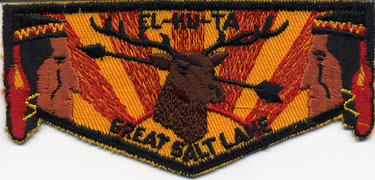
Date Issued: 1962-64
ISSUED: Unknown
DESCRIPTION: F-4a First issue: 10 twill (the number of yellow lines between the red rays.) The same as the F-3 except that the lodge number is dropped and the lettering is in black and the elk is dark brown.
F-4b Second Issue: The twill count of the second issue is 13.The Elk is lighter brown thread.
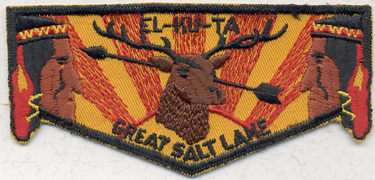
F-4c Third Issue: The faces of the Indians are apparently a new color from the other issues. The faces are a darker brown Issued in the spring of 1962 when about 220 patches were issued.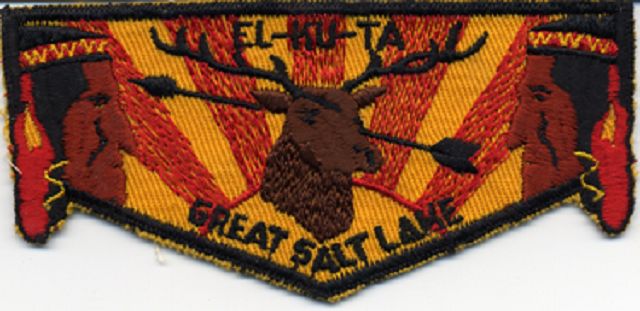 In the late fall of 1963 another run was made of an unknown quantity. The lodge was increasing its membership and with the coming of the National Jamboree in 1964 a third reordering of the F-4 was done. It is the most abundant and available of the first four flaps of the lodge. The first flaps are partially embroidered. With the 1964 National Jamboree, the lodge started to acquire a national look with a fully embroidered patch.
In the late fall of 1963 another run was made of an unknown quantity. The lodge was increasing its membership and with the coming of the National Jamboree in 1964 a third reordering of the F-4 was done. It is the most abundant and available of the first four flaps of the lodge. The first flaps are partially embroidered. With the 1964 National Jamboree, the lodge started to acquire a national look with a fully embroidered patch.
S-l 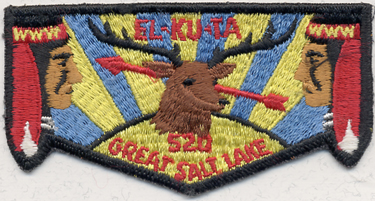
Date Issued: 1965-67
ISSUED: Unknown
DESCRIPTION: The first fully embroidered flap of the lodge. The basic design is the same but the colors were changed. The elk is redesigned with a red arrow behind its head. The Indians now have red feathers with white tips. The rays of the sun are alternating blue and yellow/gold with the lettering and lodge number in red. The border is a black cut edge. S-la First Issue: Bright yellow rays with a medium brown elk.
S-lb Second Issue: Yellow/Gold rays with a dark brown elk. The elks neck and lodge numbers overlap. 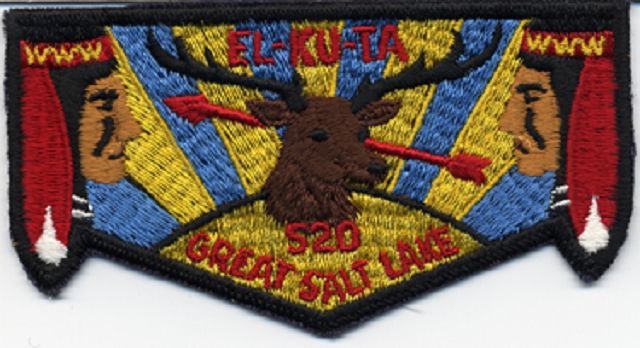 The redesign was the work of several arrowmen to bring the flap up to the standards seen at the National Jamboree. It has been speculated that the colors in the rays had something to do with the colors of a newly created Skyline High School in the area. However this seems to be more myth than fact since no confirming evidence has
The redesign was the work of several arrowmen to bring the flap up to the standards seen at the National Jamboree. It has been speculated that the colors in the rays had something to do with the colors of a newly created Skyline High School in the area. However this seems to be more myth than fact since no confirming evidence has
S-2 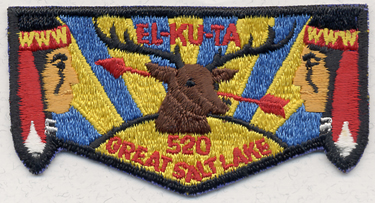
Date Issued: 1968-70
Issued: 2000 + est
DESCRIPTION: Minor changes in the color of the Indian faces. The elk's head became larger and the antlers appeared to have a shorter spread from point to point. The neck of the elk was broader and flat at the bottom. S-2a First Issue: Dark blue twilled material shoes around edge of flap.The yellow threads were changed to gold.
S-2b Second Issue: "Tar Back" Black thread shows on the back Side. Rolled edge look. Twilled material not noticeable.  It is noted for the dark black thread showing through the back (called the Tar Back). In 1969 the lodge inducted 1700 ordeal members. It is assumed that all of these members received this flap and that the number issued during the two years would have been in excess of 2000.
It is noted for the dark black thread showing through the back (called the Tar Back). In 1969 the lodge inducted 1700 ordeal members. It is assumed that all of these members received this flap and that the number issued during the two years would have been in excess of 2000.
These flaps are generally referred to as the "black border" issues. In 1970 the lodge inducted another 1900.
S-3 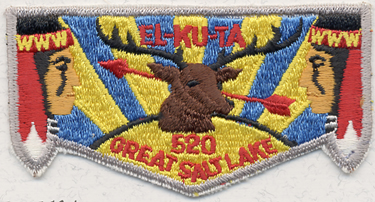
Date Issued: 1971-76
Issued: 3500 + est.
DESCRIPTION: The only change from the S-2 was the addition of a silver grey border S-3a First Issue: Cloth back with the same design as the S-2 and the silver/grey border.
S-3b Second Issue: New plastic back
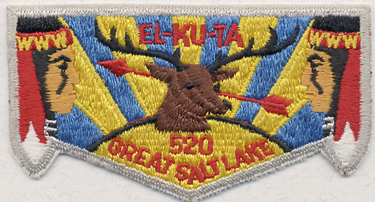
S-3c Third Issue: Light blue ray instead of the medium blue rays. It is believed by some that the addition of the border was to commemorate the lodge's 15th anniversary in 1971. 
A more accurate theory is that the change was made to provide a "new" flap for the 1973 Jamboree and National Conference. Patch trading was becoming more and more popular with the membership of the lodge and many were starting to go to the national events where other arrow men gathered. The prior flaps had pretty well flooded the market and with the Jamboree in 1968 a new change was needed and desired by those attending this event.
S-4 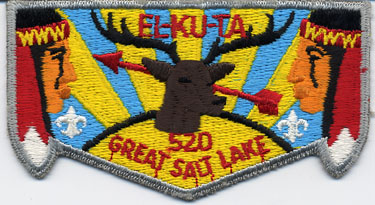
Date Issued: 1976-78
Issued: Excess of 2000
DESCRIPTION: The addition of the fleur-de-lis (fdl), horizontally stitched, in accordance with national directive. The Indian faces are orange and the white bands on their hair had been removed. The red arrow appeared to go through the eye of the elk. S-4a First Issue: Elk's head is dark brown.
S-4b Second Issue: The Elk is a lighter shade of dark brown. The changes appeared only to reflect the national policy that all scouting memorabilia show either the fleur-de-lis or the words, Boys Scouts of America. This was in order to protect the trademarks and copyrights of the Boy Scouts of America. At this time however the lodge was in the process of looking for another major change to its flap design and a number of proposals were being made.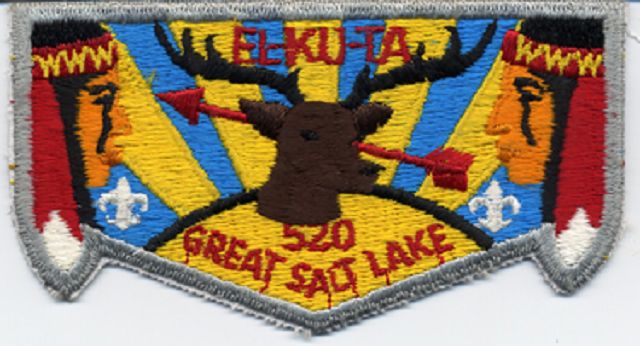
S-5 
Date Issued: 1978
Issued: Unknown
DESCRIPTION: Referred to as Second Issue of S-4. This patch is identical to S-4 except the Elk's head is medium brown and looks pleated. The Scout sign is vertically stitched and the white hair bands are returned. The other changes noted are really manufacturing changes rather than design change.
S-6 
Date Issued: 1979-81
Issued: 1000 +
DESCRIPTION: The Indian's faces were changed back to brown rather than orange and the elk was modified to have a broad vertically stitched bent neck, and a horizontally stitched fleur-de-lis. Variations exist.
S-7 
Date Issued: 1981
Issued: 1000
DESCRIPTION: Oversized design with 12 full size light green pine trees symbolizing the 12 point of the scout law and 3 snow covered mountain peaks for the 3 points of the Brotherhood of Cheerful Service. The flap has an orange-red sunset and a bright orange rolled edge. The flap was issued for the 25th Anniversary of the lodge. Each registered member was allowed to buy 2 flaps at a cost of $2.00 each. Only one run of flaps was made.
It is understood that the design was done by Kurt Holbrook (Lodge Chief 1979-80) and Robert Merrill (Lodge Chief 1980-81). Others may have been involved.
S-8 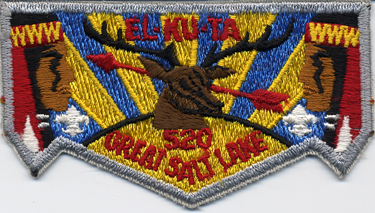
Date Issued: 1982-84
Issued: 2000 +
DESCRIPTION: Identical with the 8-6 except that the elk's head was brown with black outlining of the ears, eyes, nose and chin. The head resembled a deer. S-8a First Issue: Clear readable ed lettering. S-8b Second Issue: Blurry, thick and non-readable lettering.
Issued as the regular flap of the lodge for a 3 year period. Because of the head of he flap it became known as the "Deer head" flap. The plastic "iron on" back was placed on the flap after it was done and easily came off. Manufacturing defects were corrected by sewing over the patch including the back.
S-9 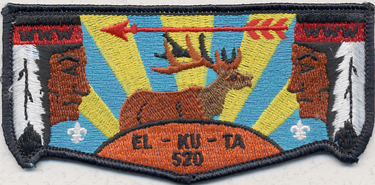
Date Issued: 1984
Issued: 1500
DESCRIPTION: A new design adopted by the lodge. Black border with a rolled edge. The Elk was that whole body with a 3-dimensional look standing on an orange globe. The feathers on the Indians were now white and black and the arrow appeared at the top of the flap.
The flap was introduced to the lodge executive committee who approved the design in the spring of 1984 The response to the flap when it was received was overwhelming, both positive and negative. The lips of the el1 appeared to be in the shape of fish lips giving rise to nick-names such as "fish lips", "sucking elk" and the one that stuck, "kissing elk". This design was basically an improvement in realism in that the ell and the Indians looked more life like. The first run of 1000 was supplemented by an additional 500 due to the size of the lodge even though the popularity of the flap was way down. It is interesting to note that after a couple of years passed the flap became very popular especially with collectors in the lodge to the point where it became difficult to find any of them. Those who had sewn them on uniforms continued a strong allegiance to the flap. The design is attributed to Eli Preston (Lodge Vice Chief 1983-84) and Ernest Preston.
S-10 
Date Issued: 1985
Issued: 1000
DESCRIPTION: With a total of 14 colors the new flap is entirely different. The elk looks three dimensional and the Indians each have 2 eagle feathers. The arrow has black a tip and feather. The addition of purple mountains and a forest and meadow in greens. The sunset is red and yellow with 11 rays. The new design was prompted by the unpopular kissing elk flap. The new design was a smashing success and most of the run was sent with the participants to the National Jamboree in 1985 Trading of the flap was the best in years. The only problem was that the sunset was too bold and covered up t e arrow. This was to be corrected on subsequent runs. At the: National Jamboree the report was that this flap was one of the most valued. Since only one run was made, it is the most rare of this design. It is commonly referred to as the "'black tip" flat due to the black tips on the arrow and it's feathers. Designed by the Lodge Officers of 1985.
S-11

DATE USED: 1985-86
Issued: 2000
DESCRIPTION: Two changes had been made in the prior issue. First the clouds ad been softened to light yellow and pink and the arrow was all red with 11 rays. The changes were made by the lodge officers to better clarify the design of the flap and make the arrow stand out more against the clouds than t had on the prior patch. It became the most popular patch of the lodge. There is no manufacture's stamp on the back.
S-12 
Date Issued: 1986 Issued: 1000
DESCRIPTION: The same design as the S-9 with the addition of a silver meltalic border and the legend "30TH ANNIV."
This is the flap that was issued to commemorate the 30th anniversary of the 1odge. It was available to registered members in 1985-86. Each member could purchase 2 flaps. Members needed to have their current registration card stamped for each flap purchased.
S-13
Date Issued: 1987
Issued: 3500 per year
DESCRIPTION: Primarily the same as the S-11 but with the manufacturers stamp on the back. The frown on the faces is a manufacturing change and not a design change from the lodge.
S-13a First Issue: Frown on the Indian faces with 11 rays. Black Celestial stamp on back.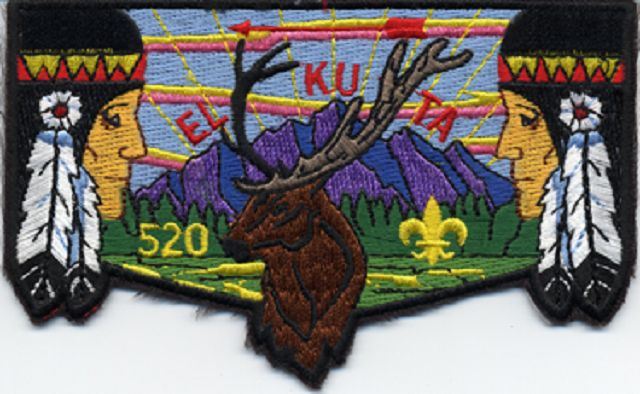
S-13b Second Issue: The same but with minor change in the face color of the Indians. The first issue is more orange and the second issue more orange/brown and has a fuzzy border. Blue Celestial stamp on back.
color of the Indians. The first issue is more orange and the second issue more orange/brown and has a fuzzy border. Blue Celestial stamp on back.
S-13c Third Issue: Smiling faces with green trees. Red Celestial stamp on back. 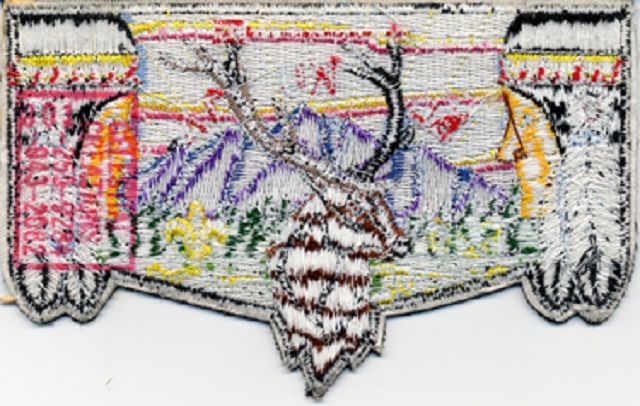
S-13d Fourth Issue: Smiling faces with green trees. Blue Celestial stamp on the back.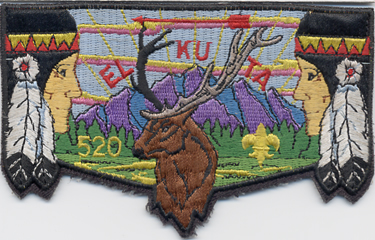
S-13e Fifth issue: The trees and the foreground are the same color of green and stitched in the same direction with 10 rays. Black made in Taiwan stamp on the back. 118 mm. wide
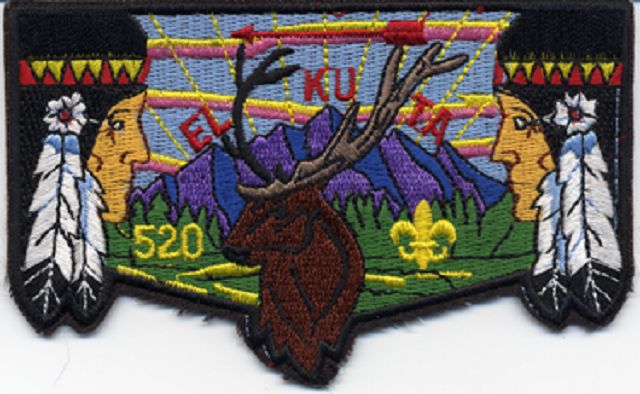
S-13f Black "Made in TAIWAN" Stamp on the back. 121 mm. wide.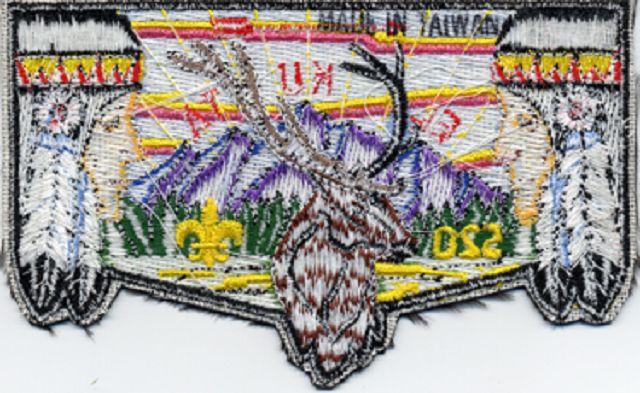
S-13g. Blue square Celestial Creations stamp on back. No smile, heavy fine stitch on Indian faces. 122mm. wide.
S-13h. Smile on faces small fine stitch. El-Ku-Ta touching mountains. 122 mm. wide.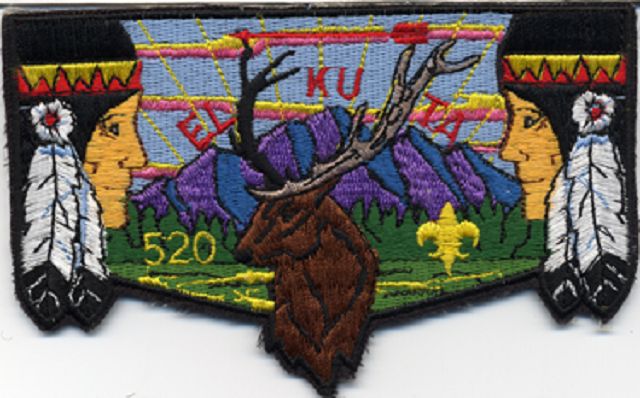
No additional history. This design became the standard of the lodge with the 1odge authorizing no new changes. As the manufacturers changed there were a certain number of minor variation in the design, It ceased to be used during 1996 with the advent of the Centennial Issue. All remaining stocks were sold with the anticipation of a new regular issue for the Jamboree in 1997. In excess of 30,000 were produced .
S-14 
Date Issued: August 1988
Issued: 300
DESCRIPTION: Pocket Flap of regular design. White Border with black lettering. Design is a miniature of the first lodge flap issued by the lodge on a white field. This flap was issued by the lodge in order to commemorate the contingent for the National Order of the Arrow Conference in 1988. Five flaps were issued to each contingent participant with the rest being able to be purchased by contingent members. The flap has an error in the spelling of Commemorative. It was tradable and extremely popular as it was the first in an anticipated series for NOAC contingents from the lodge" Designed by Steven Sugden and lodge officers.
S-15

Date Issued: 1989
Issued: 500
DESCRIPTION: The design was copied from the S-11 design and changed to represent winter. The colors are darker and the mountain snow is white and dark blue covered with dark green Vegetation. The meadow has snow colors and the Indians are more somber.
The lodge produced the flap partially as a contribution to the Council. 250 flaps ere given to the council as part of its memorabilia auction. Any donor who gave $50.00 worth of memorabilia was given a flap. The balance of the flaps have been held by the lodge as presentation items. They are awarded for outstanding performance from time to time to lodge members. In 1989 approximately 30 were given away. They cannot be purchased.
In 1990 about another 30-40 flaps were presented to various recipients. They were continued to be presented until they were gone.
S-16 
Date Issued: 1989
Issued: 1500
DESCRIPTION: The design on this flap was changed so the Indians have only one feather, there are 2 fdl's, the number of the lodge is on the neck of the elk, the head band colors have been changed to red & white.
This is referred to as a Jamboree variation and was issued for the 1989 National Jamboree only. It was felt that the contingent members needed to have a new variation to trade, since the lodge now was producing a large number of its regular flaps each year. The members wanted a variation for the Jamboree that the traders would not have, hence this variation. Prior to the Jamboree it was sold 3 per member. After the Jamboree, any quantity could be purchased through the lodge trading post. Some were given out in fall ordeal. About 900-1000 were used at the Jamboree.
S-17 
Date Issued: August 1990 Issued: 500
DESCRIPTION: Packet Flap of regular design. White Border with black lettering. Design is a miniature of the second lodge flap issued by the lodge on a white field.Used by the contingent to the conference. Each participant was issued 5 as part of the conference fee and could purchase their share of the balance left. The flap was very popular among the contingent and also among the members who wanted them for their own collections.
S-18

Date Issued: 1990
Issued: 1000
DESCRIPTION; The design on this flap was changed in that the Indians have two feathers and the head band is white with red W's, the mid-point is curved and the 75th Anniversary logo appears on the patch. With rays in silver mylar extending from it.
S-18a. 1990 was the 75th Anniversary of the founding of the Order of the Arrow. The lodge followed the practice of most lodges and issued a special commemorative patch for the event. It was limited to 2 per member until the issue was sold. Purchases required ID and were limited to members registered for the 1991 year.
S-18b. Brown and Blue mountains.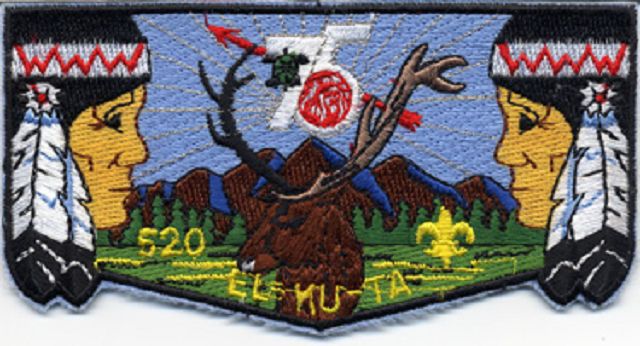
This was an extremely popular flap in the lodge and was seen on many uniforms of the members.
S-19
Date Issued: 1991
Issued: 3500 per year
DESCRIPTION: Primarily the same as the S-l1 but with the manufacturers stamp on the back. The frown on the faces is a manufacturing change and not a design change from the lodge, They both have 9 rays in the sky.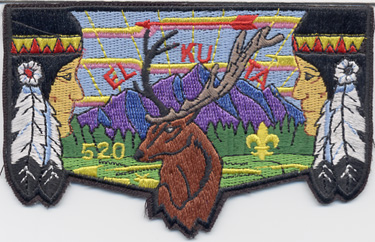
S-19a First Issue: The Elk has a I mm white eye
S-19b Second Issue: with minor change in the face color of the Indians and the Elk has a 2 mm white eye. 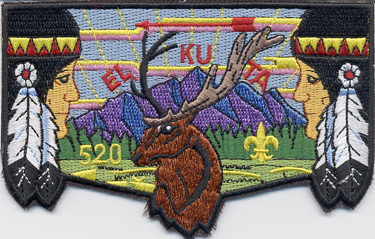
S-19c. Silver mountainc, cream fleur-de-lis and 520
S-19d. Flat nose on right Indian.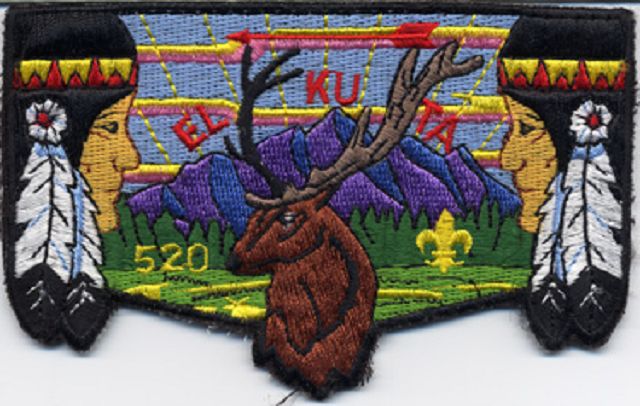
S-19e. Thin fleur-de-lis and 520.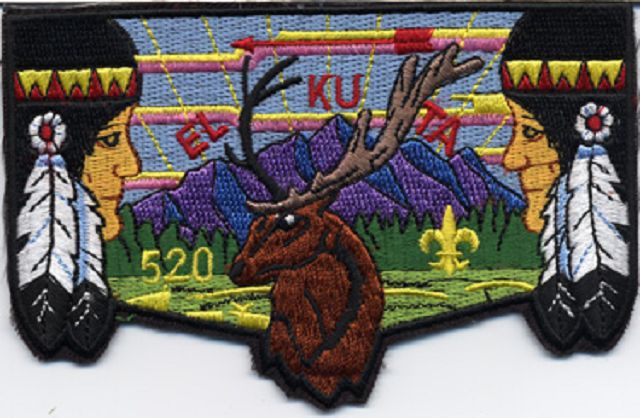
This design was the regular issue of the lodge. There are a certain number of minor variations in the design, however the basic design has remained unchanged. It ceased to be used during! 1996 with the advent of the Centennial Issue. All remaining stocks were sold with the anticipation of a new regular issue for the National Jamboree in 1997. During it's use it is estimated that in excess of 30,000 of this issue were produced and sold.
S-20 
Date Issued: 1991
Issued: 2000
DESCRIPTION: The patch is regular shape in keeping with the Anniversary issues. It shows a sunset with a white "35" in the middle of the sun. The outline in black of an Elk's head with a red arrow behind it. The border is red and the mountains are the general outline of the mountains around Camp Steiner where the lodge was formed.
The flap was issued to commemorate the 35th anniversary of the founding of the lodge at Camp Steiner.
It is supposed to represent the skyline of Steiner and its meadow. Each registered arrowmen was limited to the purchase of 2 flaps and there was only one run made. The scene is taken from Camp Steiner, the site of the founding of the Lodge in 1956. The original ceremony site at Steiner is still in use by the 1odge for its ordeals at that camp.
S-21 
Date Issued: August 1992
Issued: 500
DESCRIPTION: Pocket Flap of regular design. White Border with black lettering. Design is a miniature of the third lodge flap issued by the lodge on a white field.
Used by the contingent to the conference. Each participant was issued 5 as part of the conference fee and could purchase their share of the balance left. The flap was very popular among the contingent and also among the members who wanted them for their own collections.
S-22 
Date Issued: 1993
Issued: 1500
DESCRIPTION: The design on this flap was changed the head of the Elk is in, outline form with silver mylar as well as the 93 National Jamboree lettering, and in place of the mountains there is a waving flag with c bridge in front of it. On the bridge a scout is crossing into the future.
This is the second in a series produced for the contingent of the national jamboree. The members of the council contingent were the first to be allowed to buy them and then the membership of the lodge brought the remainder. The design was taken from the council should patch for the jamboree contingent. It is one of the more striking designs that the lodge has produced. Designed by Brad Mecham & David Halliday
S-23 
Date Issued: 1994
Issued: 1000
DESCRIPTION: Similar to the 1992 flap with a white border and in the center a miniature of the F-4 flap which was the last partially embroidered flap issued by the lodge.
Used by the 1995 contingent. The remaining flaps after the contingent returned were sold in the lodge trading post to any lodge member interested. Most were sold out within a couple of months. The conference was held at Purdue University and it was one of the first that involved a large number of our members in staff assignments.
S-24 
Date Issued: 1996
Issued: 1000
DESCRIPTION: This flap is the Centennial issue to help celebrate 100 years of Utah's Statehood. The two Indians on the sides were changed to "Akicita" meaning the messenger. One eagle eye is looking forward the other to the side. The designs on the Indian faces are different depicting individual brotherhood. The elk is outline stitched in white emerging from the background clouds. The standard Great Salt Lake Council logo is on the left and the Delicate Arch is on the right. The border is gray. It was designed by David L. Munford.
S-25 
Date Issued: 1996
Issued: 200
DESCRIPTION; This flap is the same as S-24 except the border is silver mylar. It was only sold in a framed limited edition set of the following: Centennial Lodge Flap, Centennial Council Strip, 1996 NOAC, Coup Trail 10th Anniversary, 40th Anniversary. Each flap was bordered in silver mylar thread and the set was numbered and registered to its owner at the time of issue. This set was designed by David L. Munford.
Since the 1996 flaps were so popular, it was decided to make and sell the sets and that the money raised would go into a trust fund were the interest would be used on a yearly basis to provide funds for scholarships for training and national events as well as funding for special projects.
S-26 
Date Issued: 1996
Issued: 1000
DESCRIPTION: A blue bordered regular size flap with a sky that accents the patch from black to light blue. A new side view of the elk conceals the fleur-de-lie in its shoulder. Two Indians are facing each other in headdresses denoting "Akicita" the messenger. The W's blend in a unique southwest styling on the top to make the flap unique. Designed by David L. Munford for the NOAC National Conference.
S-27 
Date Issued: 1996
Issued: 200
DESCRIPTION: Same as S-26 except with a silver mylar border. It was only sold in a framed limited edition set of the following: Centennial Lodge Flap, Centennial Council Strip, 1996 NOAC, Coup Trail 10th Anniversary, 40th Anniversary. Each flap was bordered in silver metallic border and the set was numbered and registered to its owner at the time of issue. This set was designed by David L. Munford.
S-28 
Date Issued: 1996
Issued: 1000
DESCRIPTION: A new design of the "40TH ANNIVERSARY" flap has two different Kiowa warriors, with roach headdresses in red, white and black., The 3 W's are skillfully placed over the headdresses. The mountains and foreground are in soft green with the light blue sky and white clouds. The elk is lying in the meadow. The patch is bordered in a gray non metallic thread.
This flap was also designed by David L. Munford. The emphasis on all of the 1996 flaps was to make each Indian unique and yet a pair in the design and the Elk as realistic as possible. The colors in the 1996 items are not as bold as some of the past issues in keeping with the southwest style and natural colors of the Native American. When viewed in the daylight, the 1996 issues have a three dimensional effect.
S-29 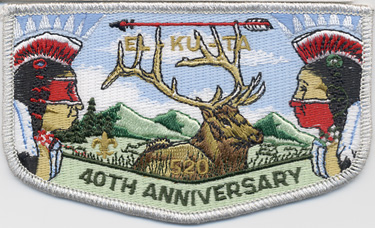
Date Issued: 1996
Issued: 200
DESCRIPTION: Same as S-28 except with a silver mylar border. It was only sold in a framed limited edition set of the following: Centennial Lodge Flap, Centennial Council Strip, 1996 NOAC, Coup Trail 10th Anniversary, 40th Anniversary. Each flap was bordered in silver metallic border and the set was numbered and registered to its owner at the time of issue. This set was designed by David L. Munford.
S-30 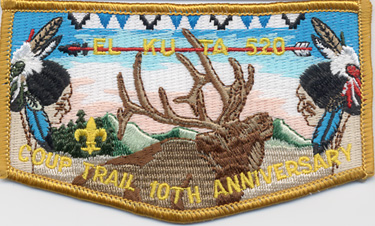
Date Issued: 1996
Issued: 1000
DESCRIPTION: Pastel colors mark this flap. The two different unique Indians have warrior headdresses and the sky is a mixture of medium blue, light blue, white and peach. The 3 W's at the top form a traditional Indian design in blue white and black. A side view of the elk in shades of brown is placed in the center of the patch. The border is non-metallic gold.
The "COUP TRAIL 10TH ANNIVERSARY" flap was produced and given to the staff and members of the 1996 course and provided at the fall Coup Trail Reunion where each former participant could purchase 2. The designer was David L. Munford and it is generally thought that this flap is the most "southwest" looking of those: issued in 1996.
S-31 
Date Issued: 1996
Issued: 200
DESCRIPTION: This flap is the same as S-30 except the border is silver mylar. It was only sold in a framed limited edition set of the following: Centennial Lodge Flap, Centennial Council Strip, 1996 NOAC, Coup Trail 10th Anniversary, 40th Anniversary. Each flap was bordered in silver metallic border and the set was numbered and registered to its owner at the time of issue. This set was designed by David L. Munford.
S-32 
Date Issued: 1996
Issued: 600
DESCRIPTION: This flap is regular in format and size. Cream ,browns, golds, and white are the colon of this unique design. It is bordered in white with a blend of colors never before put together for a lodge flap. Th(; Indians wear chief's headdresses with turquoise, white, black and red on the head bands. The arrow is red with a black arrowhead and black tipped feathers. "HOME OF THE NATIONAL CHIEF 1996" is in gold lettering The elk is laying in a meadow backed with gold and brown mountains and trees under a soft pastel sky finished in white and cream. The southwest design atop the patch camouflages the 3 W's in white, gold and black.
With the election of Ryan Pitts as the National Chief in 1996, David L. Munford was asked to design to special flap in recognition of his election.
S-33 
Issue Date: 1997
Issued: 600
DESCRIPTION: The original design and color of "HOME OF THE NATIONAL CHIEF 1996" was done in soft golds and whites. It was designed for Ryan Pitts, the National Chief in 1996. The light and dark gold threads colors did not have the contrast originally illustrated in the design. The run was made without a proof, because of time. So, this run was set aside and the S-32 flap was manufactured. Distinct characteristics are the eye and the nose of the elk outlined in black thread and the light and dark gold threads were used instead of the brown and gold in the S-32 flap.
S-34 
Date Issued: 1997
Issued: 1000
DESCRIPTION: This National jamboree flap shows off El-KU-TA lodge with A light and dark yellow star burst sunset. The lodge number 520 is in a light yellow ray, A silver mylar arrow head lies in the center. Designed in the arrow head are the three w's and the year 97. The two Indians with the eagle heads on top represent the Indians known as the messengers. The lodge name in a new style of black lettering with the fleur-de-lis designed in the Elks neck.. Bordered in silver mylar. Designed by David L. Munford
S-35 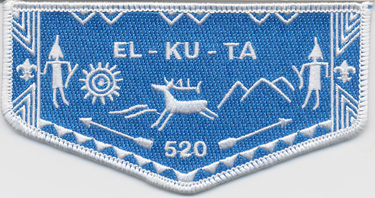
Date issued: 1998
issued: 300
DESCRIPTION; This blue and white patch tells a story with the sun and two warriors represented in the style of rock art, the two warriors depicts brotherhood, with the activities in the mountains with the lake and the elk in the center. The three w's are placed at the top of the patch to complete the Zuni Indian design. The lodge number 520 placed at the bottom with two arrows painting upward for victory and the stair step design represet knowledge. This patch is earned by arrowman who become an elangomat for the ordeals. The patch was designed by David L. Munford.
S-36 
Date issued: July 1998
Issued: 300
DESCRIPTION: This flap was designed especially for the National Order of the Arrow Conference, (NOAC) by Mike Duven, Lodge Chief. The green border cartoon like patch depicts the brotherhood tradition of the lodge and the Elk in the center. The three w's on the cheeks of the faces. Mikes initial is over each feather.
S-37 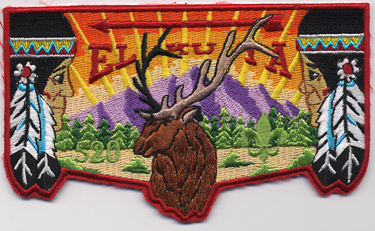
Date issued: Fall of 1998
issued: first run 2000
DESCRIPTION: A new look from the traditional patch, the new style of lettering in the sky with 12 yellow rays that represent the 12 points of the Scout Law. A large red arrow at the top of the flap in from of the sunset represents the close of the 20th Century. "The purple mountain majesty", highlighted with the pine forest at it feet and high mountain desert in the foreground. The red border and arrow is for the Order of the Arrow. Fifteen thread colors u in this flap. Designed by David L. Munford.
S-38 
Date issued: July 2000
Issued: 300
DESCRIPTION: This flap was designed especially for the National Order of the Arrow Conference, (NOAC) by David L. Munford. The blue bordered patch depicts the brotherhood tradition of the lodge. It shows snow capped mountains and a modern purple elk in the center of the moon.
S-39-A 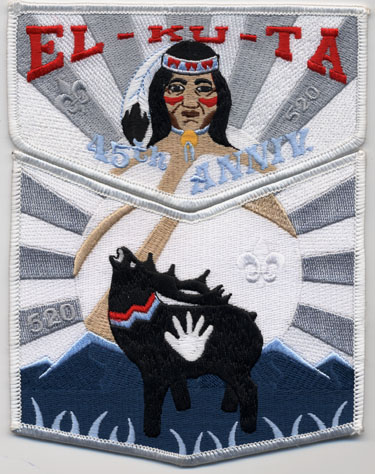
Date issued: 2001
Issue: 750
DESCRIPTION: This patch was designed by David L. Munford. The design is similar to first patch issued in the lodge and adds a new millennium design and color scheme to celebrate the 45th anniversary. The image on top of the sun represents knowledge. The patch was commissioned by the lodge officers.
S-39-B
Date issued: 2001
Issued: 750
DESCRIPTION: This bottom patch is part of the first two piece patch set in the lodge. It was designed to celebrate the 45th Anniversary. The modern look represents the new millennium. The elk stands in the center. The two designs on his neck represent brotherhood and unity, The hand represents the 5 fingered human race. The 12 white rays stand for the Scout Law. The three w's are in the grass. The lodge number (520) and the Scout Logo represents the O.A. program.
S-40-A 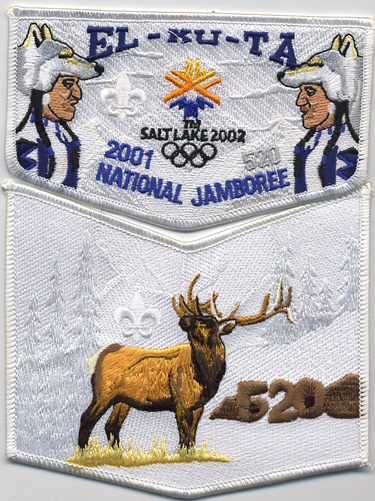
Date issued: 2001
Issue: 1200
DESCRIPTION: This patch was designed by David L. Munford to celebrate the 2001 National Jamboree and the 2002 Olympic Winter Games in Salt Lake City. The white winter background shows off the two new Indians wearing the wolf head dress. They represent brotherhood. One of the three W s in the patch is located in the center of the blue portion of the Olympic logo and the other two are on the shoulders of the Indians. This patch was approved by SLOC and made by their official manufacture. The lodge officers commissioned the patch.
S-40-B
Date issued: 2001 Issued: 800
DESCRIPTION: In the bottom patch, the elk stands alert against the snow covered forest. The three Ws are in the grass. The number 520 is on the rocks. The Scout Logo represents the O.A. program and completes this unique set.
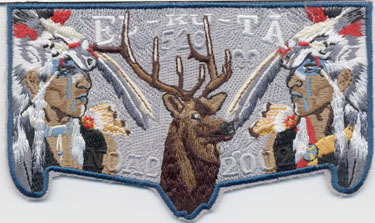 S-41
S-41
Date issued: 2002
Issue: 300
DESCRIPTION:
This patch was designed by David L. Munford for NOAC 2002, It has a dark blue border with a oak leaf gray background which depicts the natural ground cover in Utah on a rainy afternoon. The two Indians have the wolf head dress, and the elk is in the center. The event NOAC 2002 is camouflaged. The patch was commissioned by Dale Flink the Lodge Vice Chief and Bryan Paget.
S-42 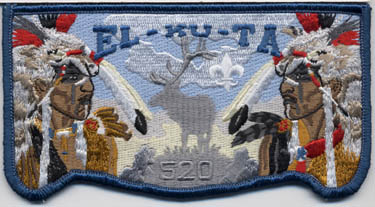
Date issued: 2004
Issue: 1500
DESCRIPTION: This blue border patch has 12 feathers representing the 12 points of the Scout Law. The three Lodge numbers represent, duty to self, God, and Country. The Scout logo represents the Scouting Program. The color scheme in the ski represents the dawn of a new Century, the 4 bushes are the four seasons and the three w's are on the shoulder of each Indian. The color red is the O.A. Obligation. The 11 blades of grass are the 11 leadership skills. The animals and birds represented in the patch are the Eagle, the Owl, the Black Wolf and Fox, representing strength and courage. The elk stands in the center of the patch in the mist representing a stead fastness in the order. The two Indians represent Brotherhood and friendship. The patch was designed by David L. Munford
S-43-A 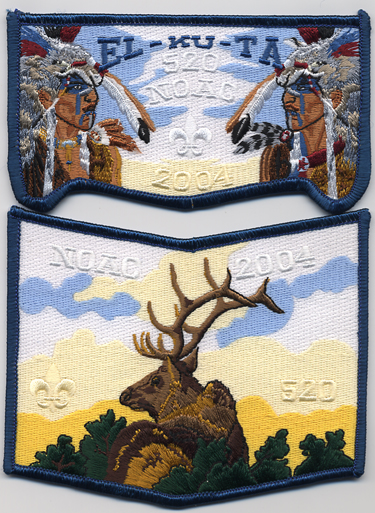
Date issued: 2004
Issue: 300
DESCRIPTION: NOAC 2004 Flap Was designed after the new blue color scheme of the lodge Flap.
The Indian on the right has the two black and gray feathers and black fur on his shoulder, with the eagle feather hanging from his headdress, and the 3 w's in a circle at the base of the feathers. The Indian on the left has
owl feathers on his shoulder and a fox pelt and 3 w's. 12 feathers are for the scout law the Indians, brothers in friendship. Noac 2004 and the scout Fleur-dis-lis are camouflaged in a soft ski representing the beginning of a new Century.
S-43-B
Date issued: 2002
Issue: 300
DESCRIPTION: NOAC 2004 Chevron is a early morning sunrise as the elk lays listening to his surroundings ready for the new challenges that await the day the three lodge letters 520, NOAC 2004 and the scout logo are camouflaged in the sky designed by David L. Munford and commissioned by David E Halliday, Lodge Adviser.
S-44-A
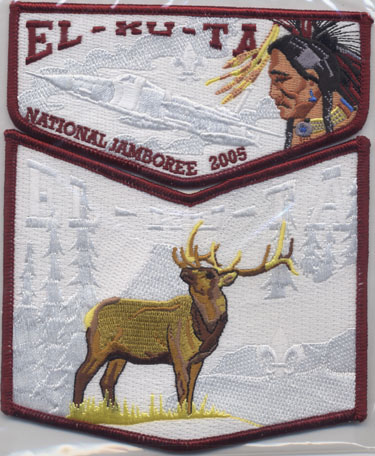
Date issued: 2005
Issue: 1000
DESCRIPTION: The Order of the Arrow Flap is a new design. The Chief in the comer is named "Big Medicine". In the clouds is a ghosted the F-105 Thunder Chief Fighter Jet. The Jet is part of the theme of the Great Salt Lake Council Jamboree patch set; "The History of Avation". The artist trained F-105 pilots on survival equipment, when he was in the Air Force stationed at Nellis AFB. the Maroon border and letters completed this stunning flap design. Designed by David L. Munford.
S-44-B
Date issued: 2005
Issue: 1000
DESCRIPTION: The bottom chevron is the Elk standing against a white back-ground with ELKUTA and the forest ghosted to match the Councils National jamboree series. The border is maroon. The patches were designed by artist David L. Munford.
S-45-A 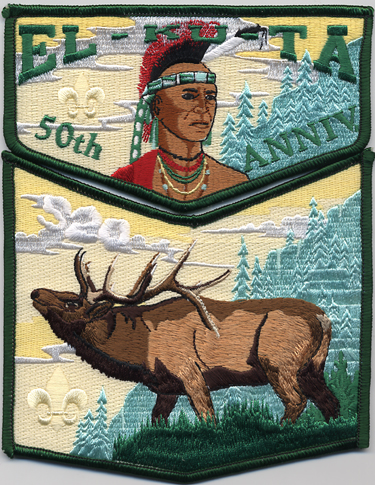
Date issued: 2006
Issue: 1100
DESCRIPTION: The Order of the Arrow Flap is a new design. The summer forest colors in the background compliments the Indian is in the Center of the flap wearing a Green and white head band. This flap was made to Celebrate the 50th Anniversary of the Lodge. The patch was designed by artist David L. Munford
S-45-B
Date issued: 2006
Issue:1100
DESCRIPTION: The bottom chevron is the Elk standing sideways against the Uinta forest scene with 520 and the fleur-de-lis ghosted in the clouds. The border is dark green and is the day version of the set. The patches were designed by artist David L. Munford and commissioned by David E Halliday, Lodge Advisor.
S-46-A 
Date issued: 2006
Issue: 1100
DESCRIPTION: The Order of the Arrow Flap is a new design. The night version of S-45 A. This flap set was made to celebrate the 50th Anniversary of the EI-Ku- Ta Lodge, the lettering in the patches is white. The patch was commissioned by David E Halliday, Artist David L. Munford
S-46-B
Date issued: 2006
Issue: 1100
DESCRIPTION: The bottom chevron is the Elk standing sideways against the uinta forest scene with 520 and the fleur-de-lis ghosted in the clouds. The border is dark blue and is the night version of this years set. The patches were designed by artist David L. Munford and commissioned by David E Halliday, Lodge Adviser.
S-47 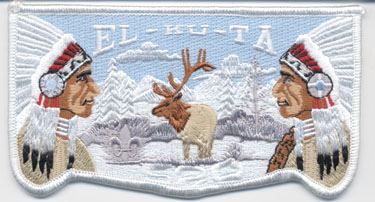
Date issued: 2009
Issue: 150
DESCRIPTION: This white bordered flap was made for the EL-KU-TA Lodge Memorabilia Auction and Trade-O- Ree held at Camp Tracy on October 16th and 17th, 2009. The patch features Allowat Sekima of the OA Ceremony. The two chiefs represent brotherhood. The three w's are in the left head dress and the elk in the center. Blair Hope was the Chairman over the event. David E Halliday was the Lodge Adviser.
S-48-A 
Date issued: 2010
Issue: 1000
DESCRIPTION: This red bordered flap was made for the EL-KU - TA Lodge for the 2010 National Scout Jamboree. The flap features two Cadillac hood ornaments to go with the Salt Flats racers theme of the general council contingent. David L. Muunford designed the set. David E Halliday was the Lodge Adviser, Caleb Cannon, Lodge Chief.
S-48-B
Date issued: 2010
Issue: 1000
DESCRIPTION: This red bordered chevron was made for the EL-KU-TA Lodge to go with the flap. The elk was designed to go with the hood ornaments in the flap. David E Halliday was the Lodge Advisor.
S-49
Date Issued: 2010
Issue: 150 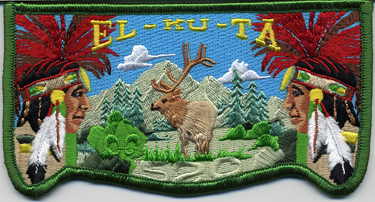
DESCRIPTION: This green bordered flap was made for the EL-KU-TA Lodge Memorabilia Auction and Trade O-Ree held at Camp Tracy on October 29th and 30th, 2010. The patch features Uncus, son of Chingachgook of thl OA ceremonies and the spring color scheme 3 w's are in the grass. Blair Hope was the Chairman over the event Caleb Cannon was the Lodge Chief.
S-50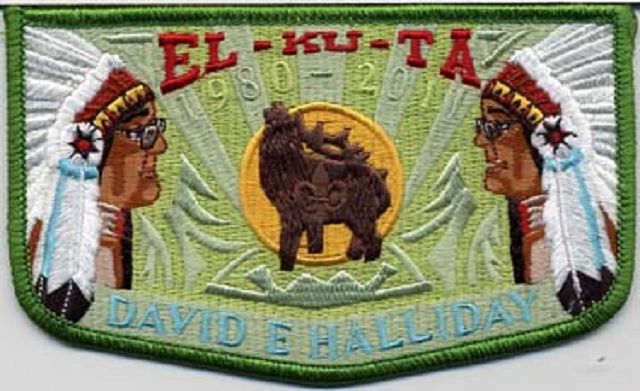
Date Issued: 2011
Issue: 200
This dark green bordered Flap was made in honor of David E Halliday, who served as El-Ku-Ta Lodge Adviser from 1980 to 2011. The design of the two Indians in Brotherhood was taken from the 1985 Flap and features his portrait. The full feathered headdress represents the leader of the tribe or chief. Continuing the journey, the elk in the flap was taken from the 45th Anniversary Flap. The elk stands in front of the sun bugling in triumph. The fleur-de-lis, ghosted in the elk, represents the ideals and values of Scouting. The background represents the pine trees,
mountains and the outdoor program of the Order of the Arrow. The red and white O.A. colors represent courage and knowledge. The three Ws are in the head band of the Indian Chiefs. The patch is being released at
Summer Fellowship 2011. David E Halliday is a legend in the El-Ku-Ta Lodge.
S-51A
Date Issued: 2011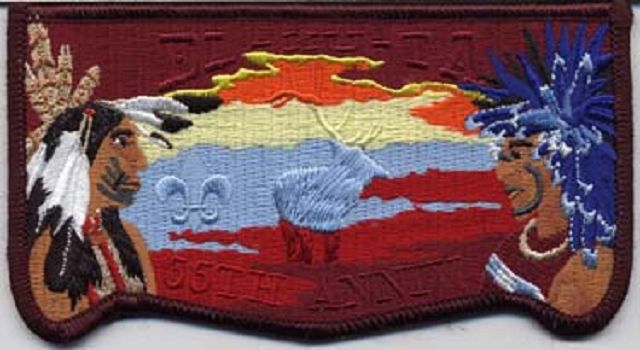
Issue: 1000
The dark marroon bordered Flap was made to celebrate the 55th Anniversary of the El-Ku-Ta Lodge. The Patch features two different Indians facing each other in brotherhood. In the background the Elk and lettering are ghosted in the sunset. The 3 W's are in the blue feathered headdress. David E Halliday was the lodge adviser.
S-51B
Date Issued: 2011
Issue: 300
This dark maroon bordered Chevron was made for the Summer Fellowship and to celebrate the 55th Anniversary of the El-Ku-Ta Lodge. The Patch features the elk standing on the side of a hill. In the background the lettering is ghosted in the sunset. The 3 W's are in the outline of the pine trees.
S-52
Date Issued: 2011 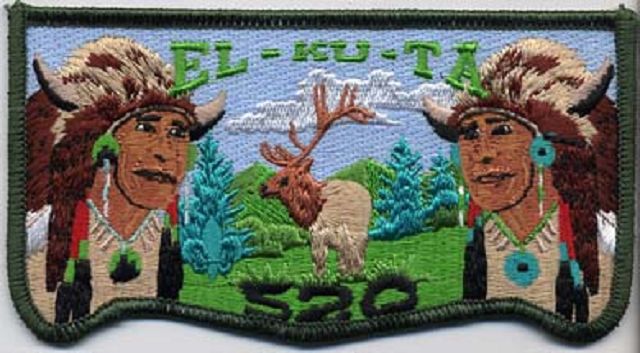
Issue: 150
This green bordered flap was made for the EL-KU-TA Lodge Memorabilia Auction and Trade-O-Ree held at Camp Tracy on November 4th and 5th, 2011. The patch features Meteu the medicine man in the OA ceremonies and the Blue Spruce, which is the State Tree. Blair Hope was the Chairman over the event.
S-53
Date Issued 2012
Issued: 150
This orange bordered flap was made for the EL-KU-TA Lodge Memorabilia Auction and Trade-O-Ree held at Camp Tracy on October 26-27, 2012. The patch features Nutikut, the Guard of the O.A. ceremonies. The fall color scheme features the elk, Utah’s State animal. The 3 Ws are in the grass by the elk. Blair Hope was the Chairman over the event. Cal Condie, Lodge Advisor. David L. Munford, Artist. 150 were made.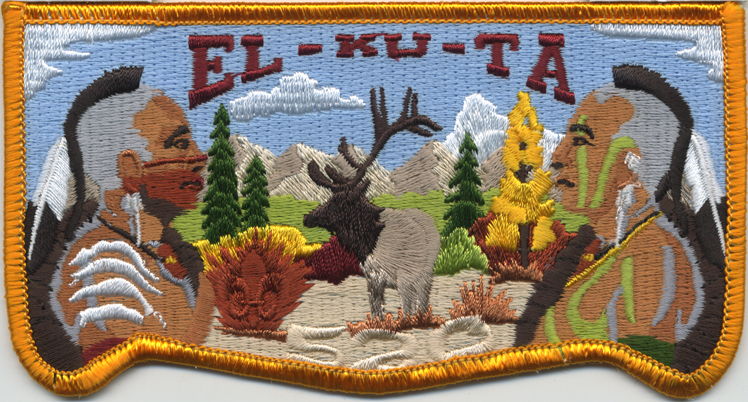
S-54 A&B
Date Issued: 2012
Issued 400 S-54A - 500 S-55B
S-54-A This blue bordered Flap was designed for the EL-KU-TA Lodge for the 2012 National Order of the Arrow Conference (NOAC) event. Cal Condie was the Lodge Advisor. David L. Munford, Artist. 400 were made.
S-54-B This chevron was designed for the Summer Fellowship for 2012. The theme was “Look to the Fire”. The patch features the elk on a mountain side. Looking to the fire. It was made to go with the 2012 NOAC Flap and also the current OA flap. Cal Condie, Lodge Advisor. David L. Munford, Artist. 500 were made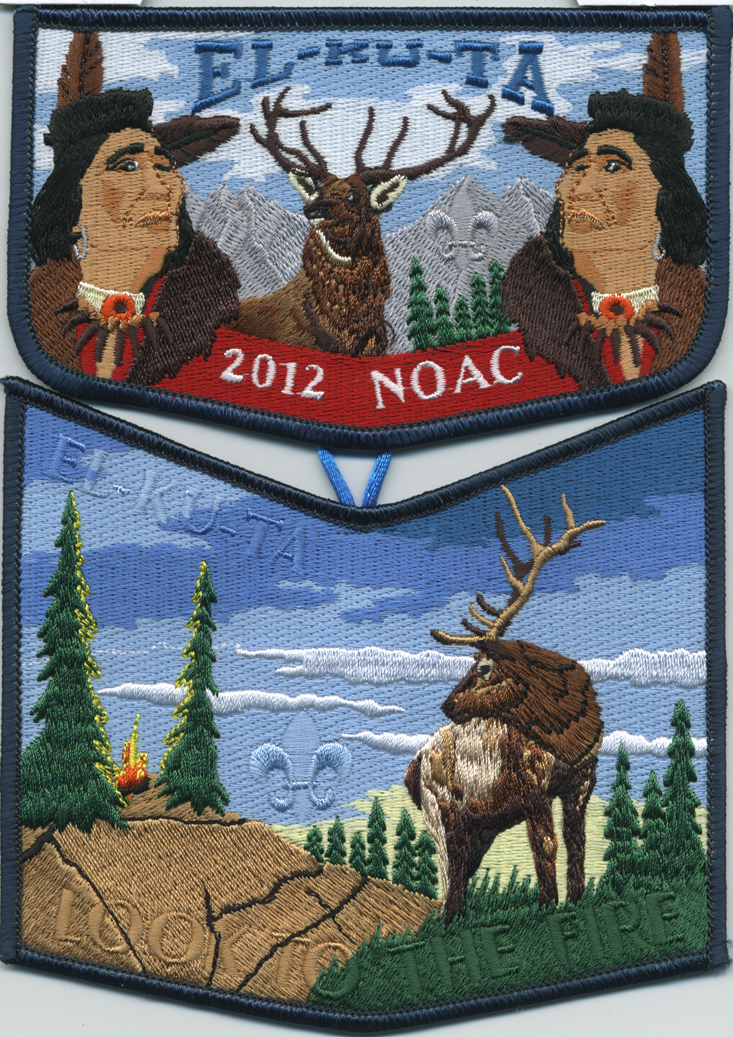
S-55 A & B
Date Issued: 2013
Issued: 750
S-55-A This maroon bordered Flap was designed for the EL-KU-TA Lodge in celebrating the 2013 National Jamboree held at Summit Bechtel Reserve, in West Virginia, on July 15 - 24. The theme for the patch was Astronomy. It features the constellation of the two Indians against the night sky. Cal Condie was the Lodge Adviser, David L. Munford the artist. 750 were made.
S-55-B This maroon bordered chevron was designed to go with the Flap for the 2013 National jamboree with the theme of the patch was Astronomy. It features the constellations rhe Elk in the night sky. Cal Condie the Lodge Adviser, David L. Munford the artist. 750 were made.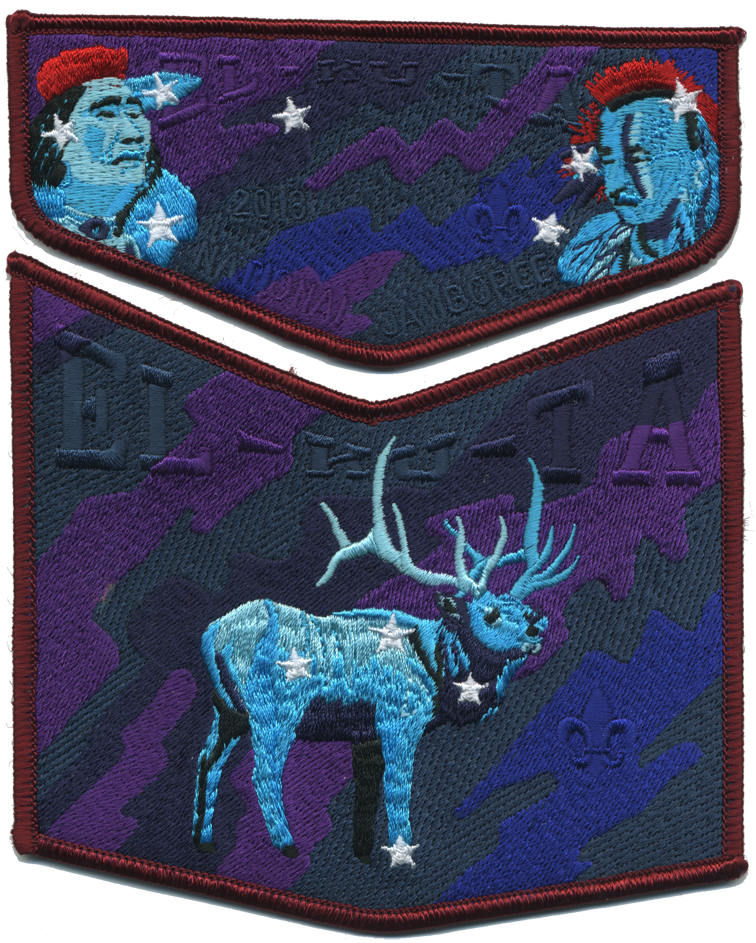
S-56
Date Issued: 2013
Issued: 150
S-56 This Flap was made for the 2013 Auction held for El-Ku-Ta Lodge The flap goes with the matching CSP and features the State Fish, the Bonneville Cut Throat Trout. The scene on the flap is underwater. Cal Condie was the Lodge Adviser, David L. Munford the artist. 150 were made
S-57-B
Date Issued 2013
Issue: 100
This blue bordered Chevron was made for adults and youth who wanted to be part of the Dance Team of El-Ku-Ta Lodge. The patch features the Native American Dancer by a fire. The elk is featured on the tee pee and the 3 ws are on the Indian's costume. the fluer-de-lis is ghosted in the sky. The Chevron is earned by learning dances, making costumes and meeting requirements set by the Lodge. The patch was designed to go with the regular blue bordered Flap, S-42. The Lodge Chief was Kaden Baker, the Lodge adviser was Cal Condie and the artist, David L. Munford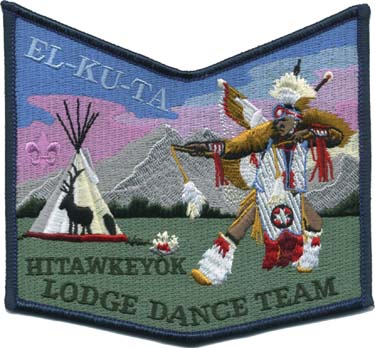
| < Prev |
|---|
Last Updated (Friday, 18 October 2013 08:37)
